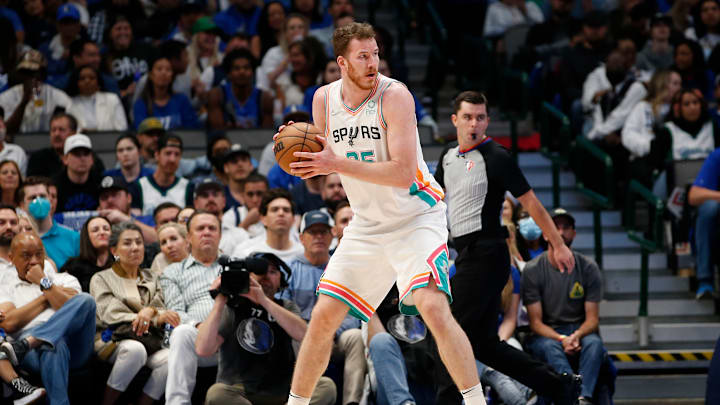After years spent fighting the inevitable, the San Antonio Spurs were forced to abandon a lineup staple, playing two big men together. Those lineups were a key part of head coach Gregg Popovich's game plan, allowing them to dominate defensively. Offensively, they were able to slow the game down and score efficiently in the half-court by relying on their stars.
Now, as the league has gotten smaller, faster, and more reliant on 3-point shooting, the Spurs have been forced to follow suit. However, Popovich did experiment with two-big-man lineups late in the season, which might've been done to see if they can still be effective in today's NBA.
The last time San Antonio started two big men was back in the first round of the 2019 NBA Playoffs against Denver, when LaMarcus Aldridge and Jakob Poeltl were paired together. Having two terrific rim protectors on the floor at the same time in addition to Derrick White was most likely done to shore up the Spurs' 19th-ranked defense.
It worked to some extent, but the lineup didn't have enough spacing and the Spurs struggled to score, resulting in them losing in seven games.
Fast forward to this season and Popovich began playing two of Poeltl, Zach Collins, and Jock Landale together, giving them a different look. Some of this experimentation probably came about because the Spurs were short-handed during the second half of the season, but the results were encouraging.

Which big-heavy lineup worked best?
The Poeltl-Landale pairing was very effective in limited minutes, posting a terrific 8.9 net rating, and provided more size, better rebounding, and added additional rim protection. It even allowed for more effective screen setting, including the use of double screens, helping to free up players such as Dejounte Murray.
On the other hand, lineups with Collins and Landale had a -3.1 net rating and struggled on offense, only scoring 104.3 points per possession compared to the Spurs' overall offensive rating of 111.9. Those lineups had limited shooting even with Landale and Collins, who can both hit threes, though they shot below league average. Meanwhile, Poeltl and Collins barely shared the floor, possibly over spacing concerns. As a result, it appears that Poeltl and Landale are the most viable combination.
Even then, San Antonio should only use two-big lineups in short bursts depending on the matchup, and they shouldn't make it a regular thing. After all, while playing big comes with certain advantages, other teams can hurt the Spurs with smaller and quicker lineups that have at least four shooters on the floor. Fortunately, the Spurs have added some much-needed shooting and perimeter defense to help them compete, while Murray could eventually help them contend.
All in all, the Spurs' use of tall-ball was likely a result of the team dealing with injuries, but one of those lineups did have some success. That said, barring significant shooting improvement from Landale and Collins or the addition of a stretch four in the draft or free agency, San Antonio would definitely be better off continuing to play small.
